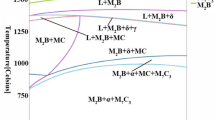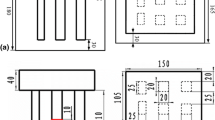Abstract
The as-cast microstructure of Fe–4Cr–B alloy has been systematically investigated, which contains 1 wt%B, 4 wt%Cr, 0.35 wt%C, 0.8 wt%Si and 0.8 wt%Mn. The investigation was carried out by optical microscopy (OM), scanning electron microscopy (EDS/SEM), X-ray diffraction (XRD), hardness tester and wear tester, and the quenching temperature effect on its microstructure and mechanical property was studied. The results showed that ferrite, pearlite, martensite and borocarbides were the main composition of the solidification microstructure of casting Fe–4Cr–B alloy. After water quenching at 950–1150 °C, the matrix transformed to martensite, and the secondary borocarbides M23 (C, B)6 precipitated from the matrix, and then the continuous distribution of M2 (B, C) (M = Fe, Cr, Mn) among dendrites began to break. As the water quenching temperature increased, the phenomenon of disconnection became more clearly. When the water quenching temperature was 1100 °C, the network borocarbides fractured and formed an isolated distribution. The hardness of the alloy increased first and then decreased. At water quenching temperature of 1100 °C, the hardness reached the maximum of 62.8 HRC. The abrasive resistance and hardness of casting Fe–4Cr–B alloy changed at the same trend.















Similar content being viewed by others
References
Gou J, Lu P, Wang Y, Liu S, and Zou Z, Appl Surf Sci 360 (2016) 849.
Nilsson A, Kirkhorn L, Andersson M, and Stahl J E, Wear 271 (2011) 1280.
Lin C H, Komeya K, Meguro T, Tatami J, Abe Y, and Komatsu M, J Ceram Soc Jpn 111 (2003) 452.
Wiengmoon A, Pearce J T H, and Chairuangsri T, Mater Chem Phys 125 (2011) 739.
Zhi X H, Liu J Z, Xing J D, and Ma S Q, Mater Sci Eng A 603 (2014) 98.
Albertin E, Beneduce F, Matsumoto M, and Teixeira I, Wear 271 (2011) 1813.
Zhang H, Fu H, Jiang Y, Guo H, Lei Y, Zhou R, and Cen Q, Mater Sci Eng Technol 42 (2011) 765.
Christodoulou P, and Calos N, Mater Sci Eng, A301 (2001) 103.
Zhang J J, Gao Y M, Xing J D, Ma S Q, Yi D W, and Yan J B, Tribol Lett 44 (2011) 31.
Yi D W, Xing J D, Ma S Q, Fu H G, Li Y F, Chen W, Yan J B, Zhang J J, and Zhang R R, Tribol Lett 45 (2012) 427.
Yi Y L, Xing J D, Wan M J, Yu L L, Lu Y F, Jian Y X, Mater Sci Eng A 708 (2017) 274.
Yüksel N, and Şahin S, Mater Design 58 (2014) 491.
Cen Q, Zhang H, and Fu H, J Iron Steel Res Int 21 (2014) 532.
Ju J, Fu H G, Fu D M, Wei S Z, Sang P, Wu Z W, Tang K Z, and Lei Y P, Ironmak Steelmak 45 (2018) 176.
Hao S, Modern Cast Iron, Metallurgical Industry Press, Beijing (2009).
Gu J, Fu H, Lei Y, and Ma S, Mater Test 57 (2015) 22.
Ma S Q, Xing J D, Fu H G, Gao Y M, and Zhang J J, Acta Mater 60 (2012) 831.
Wang S L, Cui L, He D Y, Zhou Z, and Jiang J M, Hot Work Technol 1 (2016) 30.
Xiao-Le C, Jiang J, Yin-Hu Q, Li C, and Han-Guang F, Trans Indian Inst Met 71 (2018) 2261.
Du Z Z, Li Y, Fu H G, Liu F, and Zhang H, Trans Mater Heat Treat 35 (2014) 50.
Hanguang F, Xuding S, Yongping L, Zhiqiang J, Jun Y, Jinhua W, and Jiandong X, Metals Mater Int 15 (2009) 345.
Fu H, Liu X, Yang Y, and Qu Y H Trans Indian Inst Met 71 (2018) 2423.
Buchely M F, Gutierrez J C, León L M, and Toro A, Wear 259 (2005) 52.
Acknowledgements
The authors would like to thank the financial support for this work from National Natural Science Foundation of China under grant (51775006) and Scientific Plan Item of Beijing Education Committee under Grant (009000546318529).
Author information
Authors and Affiliations
Corresponding author
Additional information
Publisher's Note
Springer Nature remains neutral with regard to jurisdictional claims in published maps and institutional affiliations.
Rights and permissions
About this article
Cite this article
Ye, T., Hanguang, F., Jian, L. et al. Microstructure and Properties of Casting Fe–Cr–B Alloy After Quenching Treatment. Trans Indian Inst Met 72, 1823–1835 (2019). https://doi.org/10.1007/s12666-019-01661-9
Received:
Accepted:
Published:
Issue Date:
DOI: https://doi.org/10.1007/s12666-019-01661-9




